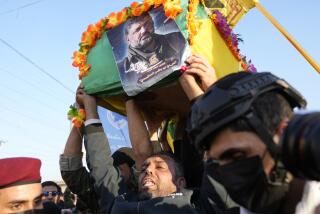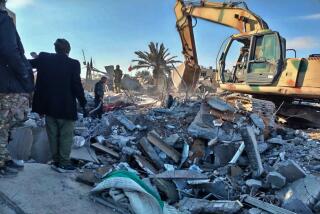Make no mistake: We’re back in an Iraq war

- Share via
Every time Barack Obama thinks he has succeeded in establishing restraint as the central doctrine of his foreign policy, a new outburst of chaos in the Middle East draws him back in. In 2011, fears that Libya’s Moammar Kadafi would massacre opponents led the United States into an air war. In 2013, Syria’s use of chemical weapons against civilians almost drew Obama into another. Now it’s Iraq, where the president thought he had disentangled the United States, only to see a new threat arise in the form of the terrorist army of the Islamic State.
Last week, when Obama first announced that he had ordered military action against the Islamists, his language was all about limits. These were “targeted airstrikes,” he said, with carefully limited goals: protecting American personnel in Kurdistan and rescuing terrified displaced Iraqis on Mt. Sinjar.
But it didn’t take long for the mission to grow. By the weekend, Obama was already talking about “a broader strategy in Iraq,” one that would help a new, improved government in Baghdad repel the fighters of the Islamic State entirely.
“We will continue to provide military assistance and advice to the Iraqi government and Kurdish forces as they battle these terrorists, so that the terrorists cannot establish a permanent safe haven,” he said, and added, “This is going to be a long-term project.”
To the inattentive, that might have looked like a new speed record for “mission creep,” the familiar tendency for U.S. military interventions to expand from modest goals to big ones. But in fact, the larger mission was already implicit in American policy — even though Obama, still a reluctant warrior, was more comfortable talking about limits than goals.
The Obama Doctrine, which has evolved through painful trial and error (see Libya and Syria), says the United States won’t use military force except when vital U.S. interests are threatened. But the “vital interest” exceptions Obama has cited include international terrorism, other threats to U.S. citizens and genocide — and all three are present in Iraq.
Indeed, the stakes in this war are immeasurably larger than the safety of Americans in Kurdistan (they could have been evacuated) or even the lives of thousands of Iraqi Yazidis on a mountain (although, yes, they deserved rescue too).
The fighters of the Islamic State “make … Al Qaeda look like Boy Scouts,” Ryan Crocker, the former U.S. ambassador to Iraq, warned recently in an interview with PBS’s “Frontline.” “They are far stronger; they are far more numerous. They have thousands [of members] who hold foreign passports and require no visas to get into the United States or other Western countries…. And they now control far more territory exclusively than [Osama] bin Laden ever did.”
“This is not a group that can go halfway,” Gen. Martin Dempsey, chairman of the Joint Chiefs of Staff, told an audience at the Aspen Institute last month. “They use brutality in a way that’s quite remarkable, even in the realm of terrorist organizations.... The United States military does consider [them] a threat — initially to the region and our close allies, longer term to the United States of America.”
So, yes, Obama was right to act forcefully, even under his own doctrine of maximum restraint. But the Obama Doctrine isn’t the same thing as an Obama strategy. Has the president charted clear goals in Iraq, and a clear path to reach them?
Not entirely. Obama has outlined some first steps: He’s trying to force Iraq’s feuding politicians to form a more inclusive government than the Sunni-hating autocracy of Prime Minister Nouri Maliki. (How? By withholding military help from Baghdad while giving aid to the Kurds, whom Baghdad hates.) He wants that new government, which doesn’t yet exist, to win wider international backing, and to rebuild the Iraqi army into a force that can beat the Islamic State on the ground.
Dempsey, with a military officer’s precision, fills in the gaps: “We are preparing a strategy … [to] initially contain, eventually disrupt and finally defeat [Islamic State] over time,” he said. (The general artfully borrowed his language from Obama’s 2009 description of U.S. goals in the struggle against Al Qaeda, when the president said he wanted to “disrupt, defeat and dismantle” the terrorist group.)
At this point, Dempsey’s clear goals are only a proposal; the strategy is still a work in progress. Major questions remain unanswered: Exactly what will be the role of U.S. military forces? What if Iraq’s leaders don’t succeed in forming a more inclusive and effective government? (The Islamic State will still be there, still a threat.) And what about Syria, where the Islamic State took root before expanding into Iraq?
Even without American boots on the ground, Obama has entered the United States in its fourth Iraq war. It won’t be over quickly. As the president said, this is going to be a long-term project.
Twitter: @DoyleMcManus
More to Read
Sign up for Essential California
The most important California stories and recommendations in your inbox every morning.
You may occasionally receive promotional content from the Los Angeles Times.














